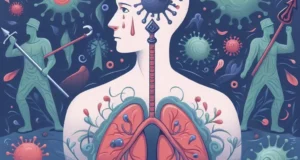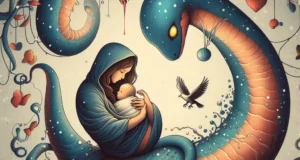Imagine a hidden bridge deep in the heart of the African rainforest—an invisible crossing where worlds once divided by species silently converge. On one side, wild animals like chimpanzees swing through the trees, unaware that their bodies carry a secret. On the other side, humans live, hunt, and survive—sometimes brushing too close to nature’s unseen lines. It is at this mysterious intersection that one of the greatest medical puzzles of the 20th century began: AIDS – where did it come from?

To understand how AIDS came to affect millions worldwide, we must first decode the concept of cross-species transmission—a scientific phenomenon where viruses jump from animals to humans. Known as zoonosis, it is like a microscopic stowaway sneaking across the species barrier on the back of blood, contact, or consumption. In the case of AIDS, this invisible leap changed the course of human history.
HIV (Human Immunodeficiency Virus), the virus that causes AIDS, didn’t originate in humans. Its ancestral version, called SIV (Simian Immunodeficiency Virus), existed quietly in the bodies of chimpanzees. For thousands of years, SIV had adapted itself to its primate hosts, rarely causing harm. But nature, as always, has its way of surprising us. At some point in the early 20th century, deep within Central Africa, a hunter came into contact with a chimpanzee’s blood—perhaps during butchering or injury while hunting. And in that very moment, the silent leap occurred.
The virus crossed over.
The species barrier was breached.
SIV became HIV.
This viral leap was not dramatic or explosive. It happened silently, like a whisper in the trees. But what followed was an echo that would thunder across decades. Once HIV entered the human bloodstream, it began evolving, slowly adapting to its new host. The virus passed from person to person, village to village, following trade routes, migrations, and growing cities.
By the time the world truly asked, “AIDS – where did it come from?”, the virus had already rooted itself deeply into human society. The first recognized cases of AIDS in the United States emerged in the early 1980s, leading to widespread panic, confusion, and misinformation. But by tracing the virus backward—like a detective following footprints in reverse—scientists uncovered its origin in African primates, and more specifically, in the moment of that cross-species transmission.
Understanding this bridge between animals and humans gives us a powerful metaphor. Think of it as a game of dominoes: the fall of one leads to a cascade of global consequences. The initial push may seem small—a single hunter, one spill of blood—but in a connected world, such tiny events can shape generations.
So, when someone wonders, “AIDS – where did it come from?”, the answer lies not just in laboratories or genetics, but in the complex dance between nature and humanity. It’s a reminder that we are never truly separate from the ecosystems we live in. Viruses don’t respect human-made borders or species lines. They travel silently, waiting for the chance to cross over.

Today, the story of HIV serves as a vital lesson in public health, wildlife interaction, and preparedness. The invisible bridge is still there. Other viruses—like Ebola, SARS, and even COVID-19—have taken similar leaps. Knowing where AIDS came from helps us remain alert to future threats and reminds us of the delicate balance between coexistence and consequence.
It came from a forgotten handshake between species—a moment when nature tapped us on the shoulder and whispered, “You are not alone.”




